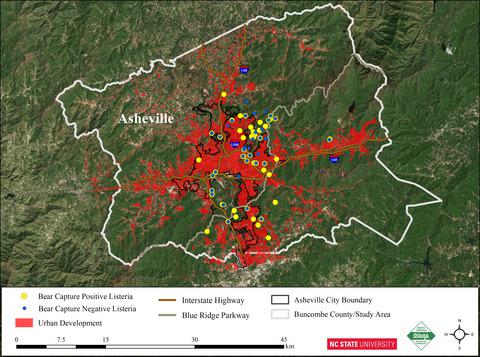当前位置:
X-MOL 学术
›
Microb. Biotechnol.
›
论文详情
Our official English website, www.x-mol.net, welcomes your
feedback! (Note: you will need to create a separate account there.)
Listeria monocytogenes at the human-wildlife interface: black bears (Ursus americanus) as potential vehicles for Listeria.
Microbial Biotechnology ( IF 4.8 ) Pub Date : 2019-11-11 , DOI: 10.1111/1751-7915.13509 Cameron Parsons 1 , Jeff Niedermeyer 1 , Nicholas Gould 2 , Phillip Brown 1 , Jennifer Strules 2 , Arielle W Parsons 2, 3 , J Bernardo Mesa-Cruz 4, 5 , Marcella J Kelly 4 , Michael J Hooker 6 , Michael J Chamberlain 6 , Colleen Olfenbuttel 7 , Christopher DePerno 2 , Sophia Kathariou 1
Microbial Biotechnology ( IF 4.8 ) Pub Date : 2019-11-11 , DOI: 10.1111/1751-7915.13509 Cameron Parsons 1 , Jeff Niedermeyer 1 , Nicholas Gould 2 , Phillip Brown 1 , Jennifer Strules 2 , Arielle W Parsons 2, 3 , J Bernardo Mesa-Cruz 4, 5 , Marcella J Kelly 4 , Michael J Hooker 6 , Michael J Chamberlain 6 , Colleen Olfenbuttel 7 , Christopher DePerno 2 , Sophia Kathariou 1
Affiliation

|
Listeria monocytogenes is the causative agent of the foodborne illness listeriosis, which can result in severe symptoms and death in susceptible humans and other animals. L. monocytogenes is ubiquitous in the environment and isolates from food and food processing, and clinical sources have been extensively characterized. However, limited information is available on L. monocytogenes from wildlife, especially from urban or suburban settings. As urban and suburban areas are expanding worldwide, humans are increasingly encroaching into wildlife habitats, enhancing the frequency of human–wildlife contacts and associated pathogen transfer events. We investigated the prevalence and characteristics of L. monocytogenes in 231 wild black bear capture events between 2014 and 2017 in urban and suburban sites in North Carolina, Georgia, Virginia and United States, with samples derived from 183 different bears. Of the 231 captures, 105 (45%) yielded L. monocytogenes either alone or together with other Listeria. Analysis of 501 samples, primarily faeces, rectal and nasal swabs for Listeria spp., yielded 777 isolates, of which 537 (70%) were L. monocytogenes. Most L. monocytogenes isolates exhibited serotypes commonly associated with human disease: serotype 1/2a or 3a (57%), followed by the serotype 4b complex (33%). Interestingly, approximately 50% of the serotype 4b isolates had the IVb‐v1 profile, associated with emerging clones of L. monocytogenes. Thus, black bears may serve as novel vehicles for L. monocytogenes, including potentially emerging clones. Our results have significant public health implications as they suggest that the ursine host may preferentially select for L. monocytogenes of clinically relevant lineages over the diverse listerial populations in the environment. These findings also help to elucidate the ecology of L. monocytogenes and highlight the public health significance of the human–wildlife interface.
中文翻译:

人类与野生动物界面的单核细胞增多性李斯特菌:黑熊(Ursus americanus)作为李斯特菌的潜在媒介。
单核细胞增生李斯特菌是食源性疾病李斯特菌病的病原体,可导致易感人类和其他动物出现严重症状和死亡。单增李斯特氏菌在环境中普遍存在,并从食品和食品加工中分离出来,临床来源已得到广泛表征。然而,有关野生动物(尤其是城市或郊区)的单核细胞增生利斯特氏菌的信息有限。随着城市和郊区在全球范围内不断扩张,人类越来越多地侵入野生动物栖息地,从而增加了人类与野生动物接触的频率以及相关的病原体转移事件。我们调查了 2014 年至 2017 年间北卡罗来纳州、佐治亚州、弗吉尼亚州和美国城市和郊区的 231 起野生黑熊捕获事件中单核细胞增多性李斯特菌的流行情况和特征,样本来自 183 只不同的熊。在 231 次捕获中,105 次 (45%) 单独产生单核细胞增生李斯特菌或与其他李斯特菌一起产生。对 501 个样本(主要是粪便、直肠和鼻拭子)进行李斯特菌分析。 ,产生了 777 个分离株,其中 537 个(70%)是单核细胞增生李斯特菌。大多数单增李斯特菌分离株表现出通常与人类疾病相关的血清型:血清型 1/2a 或 3a (57%),其次是血清型 4b 复合体 (33%)。有趣的是,大约 50% 的血清型 4b 分离株具有 IVb-v1 谱,与单核细胞增生李斯特菌的新兴克隆相关。因此,黑熊可能作为单核细胞增生利斯特氏菌的新型载体,包括潜在的新克隆。 我们的结果具有重大的公共卫生意义,因为它们表明熊宿主可能会优先选择临床相关谱系的单核细胞增生李斯特菌,而不是环境中不同的李斯特菌群体。这些发现也有助于阐明L的生态学。单核细胞增生症并强调人类与野生动物接触的公共卫生意义。
更新日期:2019-11-11
中文翻译:

人类与野生动物界面的单核细胞增多性李斯特菌:黑熊(Ursus americanus)作为李斯特菌的潜在媒介。
单核细胞增生李斯特菌是食源性疾病李斯特菌病的病原体,可导致易感人类和其他动物出现严重症状和死亡。单增李斯特氏菌在环境中普遍存在,并从食品和食品加工中分离出来,临床来源已得到广泛表征。然而,有关野生动物(尤其是城市或郊区)的单核细胞增生利斯特氏菌的信息有限。随着城市和郊区在全球范围内不断扩张,人类越来越多地侵入野生动物栖息地,从而增加了人类与野生动物接触的频率以及相关的病原体转移事件。我们调查了 2014 年至 2017 年间北卡罗来纳州、佐治亚州、弗吉尼亚州和美国城市和郊区的 231 起野生黑熊捕获事件中单核细胞增多性李斯特菌的流行情况和特征,样本来自 183 只不同的熊。在 231 次捕获中,105 次 (45%) 单独产生单核细胞增生李斯特菌或与其他李斯特菌一起产生。对 501 个样本(主要是粪便、直肠和鼻拭子)进行李斯特菌分析。 ,产生了 777 个分离株,其中 537 个(70%)是单核细胞增生李斯特菌。大多数单增李斯特菌分离株表现出通常与人类疾病相关的血清型:血清型 1/2a 或 3a (57%),其次是血清型 4b 复合体 (33%)。有趣的是,大约 50% 的血清型 4b 分离株具有 IVb-v1 谱,与单核细胞增生李斯特菌的新兴克隆相关。因此,黑熊可能作为单核细胞增生利斯特氏菌的新型载体,包括潜在的新克隆。 我们的结果具有重大的公共卫生意义,因为它们表明熊宿主可能会优先选择临床相关谱系的单核细胞增生李斯特菌,而不是环境中不同的李斯特菌群体。这些发现也有助于阐明L的生态学。单核细胞增生症并强调人类与野生动物接触的公共卫生意义。











































 京公网安备 11010802027423号
京公网安备 11010802027423号